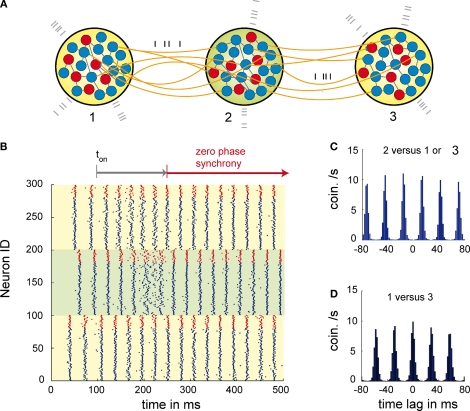Figure 1.
Dynamics of three networks of excitatory and inhibitory neurons interacting through dynamical relaying. (A) Topology of the relaying motif. Here, three networks 1, 2, 3 each composed of 20 inhibitory (red) and 80 excitatory (blue) neurons. To control the activity level of each population external Poisson input is used (grey spikes). The conductions delays are 12 ms and therefore significant compared to the period of the oscillation. (B) Raster plot of the activity of each neuron of population 1 (neurons 1–100), population 2 (neurons 101–200) and population 3 (neurons 201–300). Blue spikes are from the excitatory and red spike from the inhibitory neurons. At coupling ton at 100 ms the coupling between the populations was activated. After 90 ms of activated coupling P1 and P3 start being zero-phase synchronized. The whole synchronization period lasts about 130 ms. Note that the activity of the relaying population P2, gets less synchronized due to individual phase adaptations of P2 neurons during the synchronization period between 160 and 230 ms. This indicates that the relaying population P2 is not acting as a master that entrains P1 and P3, but that synchronization is established between P1 and P3 via relaying of activity through P2. (C) Average cross-correlation between population P1 or P3 and the relaying population P2. (D) Average cross correlation between the outer populations P1 and P3.

